The Future of Philippine Sports: Challenges and Opportunities
A Youthful Population Drives Sports Participation
The Philippines has a young population, with over 50% of its citizens under the age of 25. This demographic trend contributes to the growing interest in sports, particularly in basketball, which is an integral part of the country's culture.
Recent Successes and Emerging Trends
The country's recent success in the Olympics and the rapid growth of its esports sector present promising opportunities for the future of Philippine sports.
The Philippines won its first Olympic gold medal in 2021, and its esports industry is projected to reach $23 million by 2025.
Infrastructure Gaps and Government Investment
Despite these opportunities, the country faces significant challenges, particularly in terms of infrastructure gaps and the need for government investment.
The Philippines ranks 95th out of 136 countries in terms of sports infrastructure, according to the Global Sports Index.
Technology and Grassroots Programs
To overcome these challenges, technology plays a vital role in improving performance, and grassroots programs are essential for nurturing talent.
For example, the use of data analytics can help athletes optimize their training, while programs like the Philippine Sports Commission's "Sports for Peace" initiative aim to develop sports programs in rural areas.
By understanding these factors, it is clear that the future of Philippine sports is dynamic and complex, with both challenges and opportunities waiting to be addressed.
Demographic Insights and Market Potential
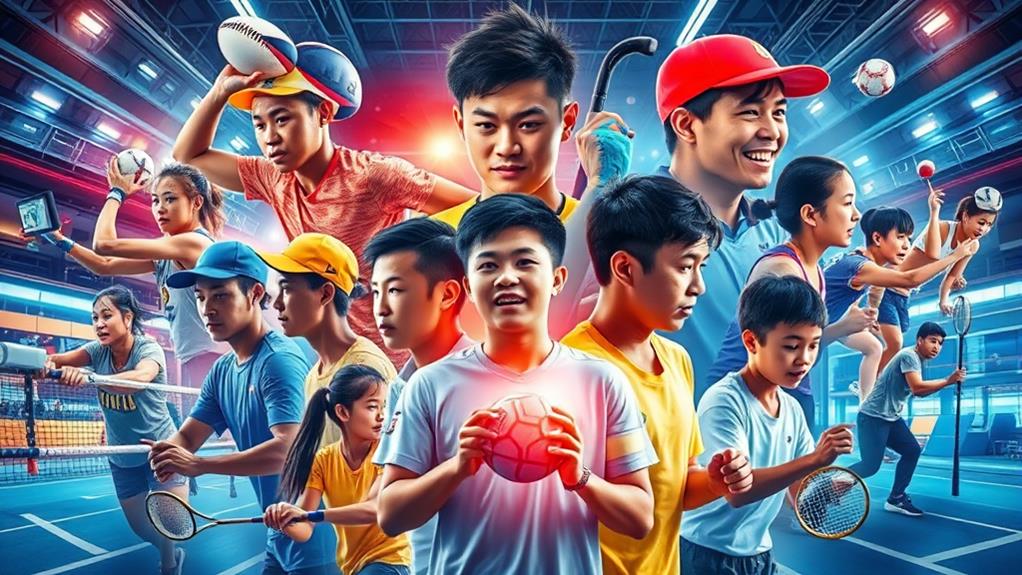
Demographic Insights Shape the Philippine Sports Landscape
The Philippines' youthful population, with over 50% of its 110 million citizens under the age of 25, drives significant engagement in both traditional sports and esports. This demographic creates a dynamic market potential that's hard to ignore.
Sports Are Deeply Rooted in Filipino Culture
Over 75% of Filipinos identify as basketball fans, underscoring the cultural significance of sports in this country. This enthusiasm can be tapped into to foster grassroots development, which is vital for nurturing talent and expanding participation across various sports.
International Events and Government Support Open Opportunities
The Philippines hosting international events like the FIBA Basketball World Cup 2023 puts the spotlight on local athletes and programs.
The government's support for sports initiatives, combined with growing media coverage, opens doors for companies looking to invest in grassroots programs.
Esports Presents a Fresh Avenue for Investment and Engagement
With over 43 million active gamers, the burgeoning esports market signals a fresh avenue for investment and engagement.
Basketball's Role in National Identity
Basketball is an integral part of Filipino identity, transcending mere sport to become a cherished cultural phenomenon. With over 75% of Filipinos identifying as fans, it's clear that basketball isn't just a pastime; it's a unifying force that fosters community engagement.
The Philippine Basketball Association (PBA), established in 1975 as Asia's first professional league, highlights the sport's prominence and serves as a platform for local talent.
The NBA brand's near-universal awareness in the Philippines, approaching 99%, demonstrates the sport's immense popularity and influence on local culture.
Grassroots initiatives and community events nurture local talent and create shared experiences that resonate deeply with Filipinos. Basketball embodies values like teamwork and resilience, reflecting a national identity that thrives on unity and passion.
In the realm of sports, basketball stands as a vital pillar, connecting generations and inspiring hope for a brighter future in Philippine sports.
The Philippines' commitment to basketball is further showcased through upcoming events, like the hosting of the FIBA Basketball World Cup 2023 group phase, promising to elevate its profile even higher.
Achievements of Filipino Athletes
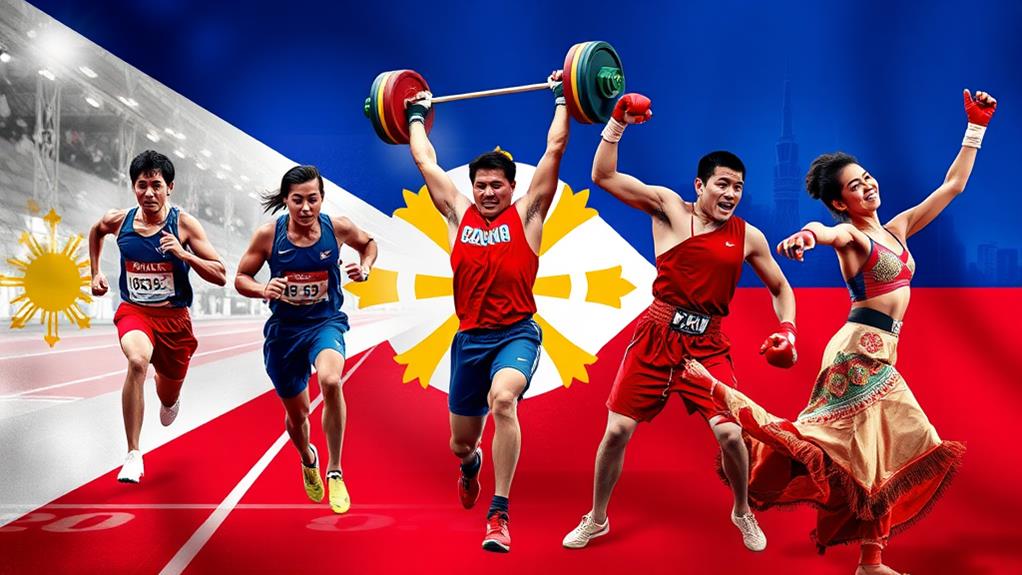
Filipino athletes have consistently showcased their remarkable talent and determination on both regional and global stages.
Their achievements reflect not just individual brilliance but also the strength of grassroots programs that nurture young talent across the nation.
For instance, at the Tokyo 2020 Olympics, the Philippines celebrated its historic success with four medals, including the groundbreaking gold medal in weightlifting by Hidilyn Diaz. This achievement marked a significant milestone, inspiring future generations to pursue sports.
The Philippines ranked 4th in the medal standings at the SEA Games 2021, demonstrating the nation's growing competitiveness in regional sports.
The women's football team made headlines by qualifying for the 2023 FIFA World Cup, signaling an important shift in the recognition and development of women's sports.
Boxing remains a proud tradition, with Filipino boxers earning multiple world championship titles, further cementing the country's reputation in the sport.
As you look at these achievements, it's clear that the dedication and hard work of Filipino athletes, combined with supportive grassroots initiatives, lay a solid foundation for future success in sports.
Esports Growth and Opportunities
The Philippines is Emerging as a Significant Player in the Global Esports Scene
The country has a thriving esports industry, driven by a large and dedicated community of over 43 million active gamers. This has led to a 12.9% year-over-year increase in esports growth since 2017, making it an attractive market for investment.
Several Factors are Contributing to this Rapid Growth
Major international tournaments are being held in the Philippines, boosting its reputation in the global esports arena.
Local esports organizations are emerging, providing a platform for talented gamers to gain recognition.
Increasing sponsorships are offering financial support and resources to gamers and teams.
Strong community engagement is also driving growth, with fans passionately supporting their favorite players and teams.
This Growth Presents Lucrative Opportunities for Gamers and Investors
The mobile gaming market in the Philippines is projected to reach $1.5 billion by 2025, making it an attractive market for investment.
With the esports industry in the Philippines continuing to grow, gamers and investors alike can benefit from this trend.
Infrastructure Needs and Development
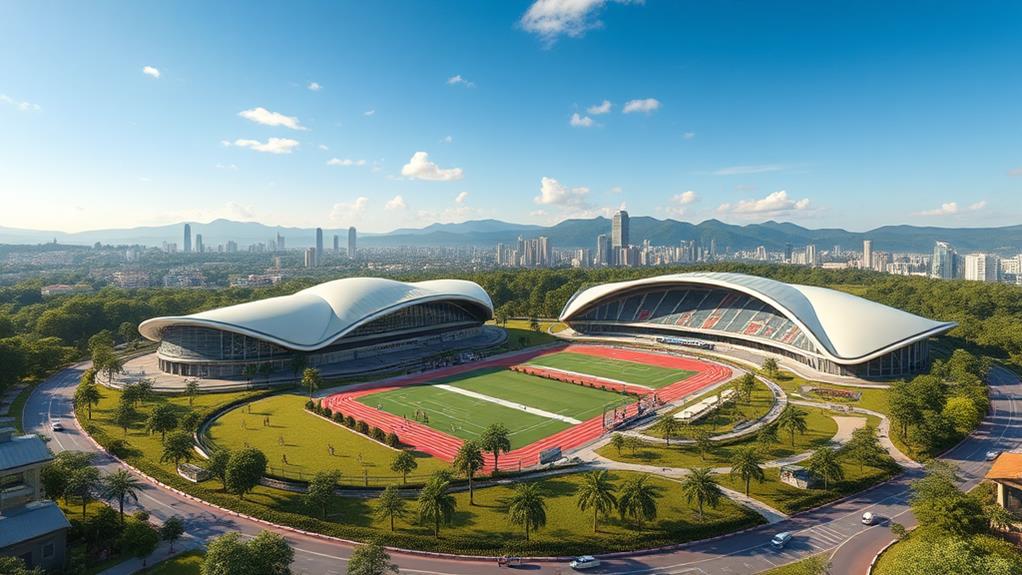
Building a robust sports infrastructure is crucial for the Philippines to unlock its full athletic potential. The government's increased budget for sports development highlights the need for more stadiums and parks, which can significantly enhance community engagement in sports activities.
Investment in grassroots development and regional training centers is vital for nurturing young talent.
Understanding the current landscape requires examining the following infrastructure needs:
Advanced Training Academies: Provide athletes access to essential resources, such as expert coaches, modern equipment, and sports science facilities.
Improved Sports Facilities: Ensure adequate venues for training and competition, including stadiums, tracks, and fields that meet international standards.
Public-Private Partnerships: Fuel funding for grassroots programs by collaborating with private organizations to support sports development initiatives.
Government Funding Initiatives: Increase support through PAGCOR and PCSO revenues, allocating a significant portion of the budget to sports development projects.
The recent Supreme Court ruling significantly boosts funding for infrastructure development, but the pressing need for advanced training academies remains.
By fostering public-private partnerships, the Philippines can enhance its overall sports infrastructure, ensuring that aspiring athletes have the resources they need to succeed.
Addressing these infrastructure needs will pave the way for a brighter future in Philippine sports.
Technology's Impact on Sports
Technology is transforming the sports landscape in the Philippines by driving innovation, performance, and engagement. This shift is evident in training methods and competitive environments, where athletes are leveraging technology to enhance their skills.
Data analytics plays a crucial role in refining performance and preventing injuries. For instance, athletes can analyze their game footage to identify areas for improvement and track their progress over time.
Wearable technology is another key aspect, providing real-time feedback during training. Devices such as heart rate monitors and GPS trackers help athletes monitor their health metrics and optimize their performance.
The growth of esports is a significant indicator of technology's impact on sports. The rapid expansion of the sector demonstrates its ability to engage younger audiences and provide new opportunities for athletes and fans alike.
Virtual events have also become increasingly important, particularly during the pandemic. Online competitions have enabled sports to continue despite physical distancing measures, ensuring that athletes can still compete and fans can still engage with their favorite sports.
Investing in technology for sports delivery is essential to appeal to the digitally savvy youth demographic and enhance training experiences.
Community Engagement in Sports
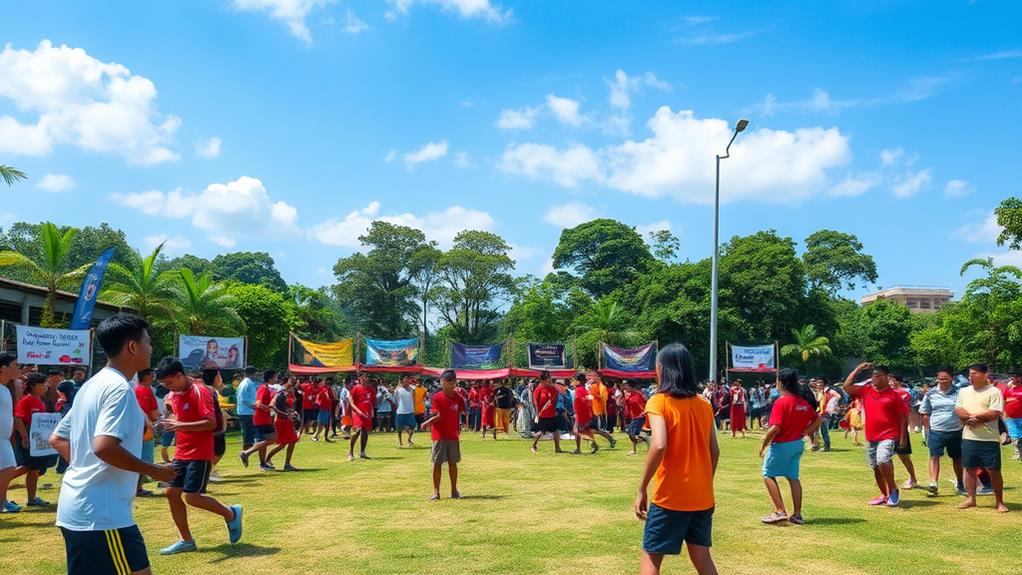
Community engagement in sports is vital for building unity and inclusivity in the Philippines. By participating in local initiatives, individuals help strengthen community ties and promote inclusivity.
For instance, grassroots programs are essential for developing young talent, especially since many aspiring athletes lack access to resources and platforms to nurture their skills.
Supporting community events and partnerships enhances fan engagement and creates supportive environments for athletes. This focus on community engagement emphasizes the importance of mental health and well-being, reminding us that sports can be a vital outlet for stress relief and social connection.
The rise of virtual events has also helped maintain connections among sports participants, providing alternative avenues for competition during disruptions like the pandemic.
Investment in community sports facilities, such as parks and training centers, is crucial. These facilities not only promote physical activity but also create numerous opportunities for residents to engage in sports, ultimately enriching the community and fostering a love for athleticism.
How Can Developing Well-Rounded Individuals in Sports and Education Help Shape the Future of Philippine Sports?
Developing well-rounded individuals in sports and education in the philippines can greatly impact the future of Philippine sports. By providing opportunities for young athletes to excel both academically and athletically, we can potentially produce more well-rounded and disciplined athletes who can represent the country on the international stage.
Investment Importance and Strategies
Investment in Philippine sports is crucial for creating a thriving athletic ecosystem that can succeed locally and internationally. With the Supreme Court ruling mandating increased remittances to the Philippine Sports Commission, an additional P19.5 billion is expected by year-end, highlighting the importance of investing in infrastructure and athlete development.
Effective Coaching is Key. To improve athlete performance, allocate funds to enhance coaching quality, bridging existing gaps in athlete training. This can be achieved by providing coaching certifications, workshops, and training programs for local coaches.
Grassroots Initiatives Drive Talent Development. Invest in local talent development to create pathways for young athletes. For instance, the proposed National Academy of Sports can provide training facilities, coaching, and mentorship to young athletes, helping them develop their skills and reach their full potential.
Public-Private Partnerships Ensure Equitable Access. Collaborate with private sector stakeholders and local governments to ensure equal access to facilities and resources. This partnership can lead to the development of more sports facilities, equipment, and training programs, benefiting athletes from all backgrounds.
Promoting Sports Engagement Fosters a New Generation of Champions. Increase funding for community sports programs to cultivate a new generation of enthusiasts and champions. This can be achieved by supporting school sports programs, community leagues, and sports clinics, making sports more accessible and enjoyable for all.
Future Trends in Sports Participation
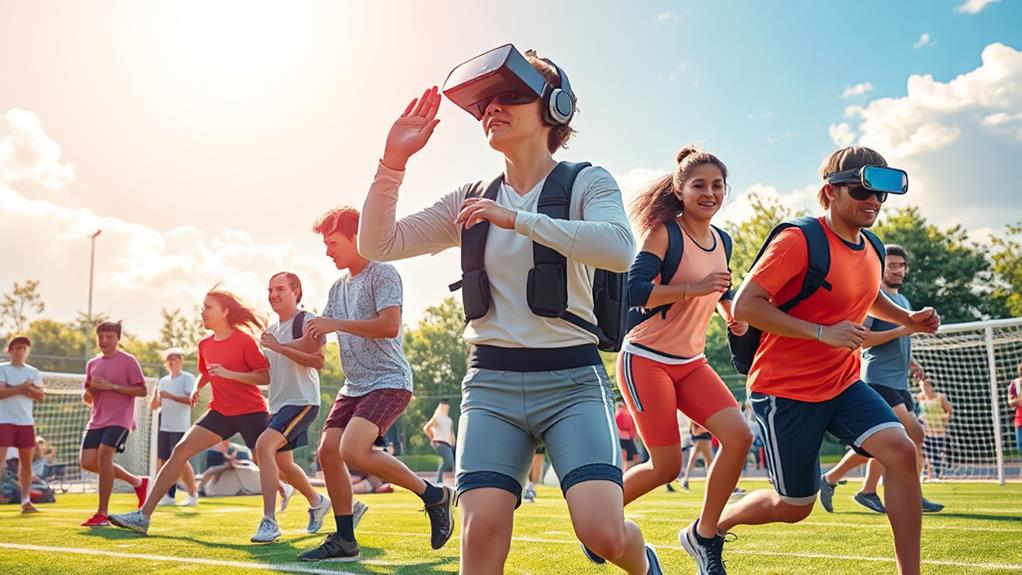
The Philippines' youthful demographic is driving a significant shift in sports participation. With an average age under 25, the nation's 110 million people are increasingly engaging in various sports and esports activities.
The upcoming FIBA Basketball World Cup 2023 will amplify this trend. Over 75% of Filipinos are already passionate basketball fans, making the event a catalyst for further growth.
Community events and inclusive programs are fostering a more diverse sports culture. At the grassroots level, initiatives like these are enhancing local engagement and encouraging participation among underrepresented groups.
For instance, programs that provide access to sports facilities and training for disadvantaged youth are helping to bridge the gap.
Technology will redefine training experiences. The use of virtual reality and data analytics will make sports more appealing to the digitally savvy youth.
For example, virtual reality can simulate game scenarios, allowing athletes to practice and improve their skills in a more immersive and engaging way.
Government support and strategic investments in sports infrastructure are crucial to sustaining these trends. By overcoming existing challenges, the Philippines can cultivate a thriving sports ecosystem that empowers young athletes and nurtures their talents.
Investments in modern sports facilities, for instance, can provide athletes with access to better training equipment and conditions.
The future of sports participation in the Philippines looks bright. With a focus on community development and embracing technology, the nation can unlock opportunities for growth and empower its young athletes to succeed.
Questions and Answers
What Are the Philippine Sports Issues and Controversies?
Corruption Scandals Hinder Philippine Sports Development
Philippine sports have been significantly impacted by corruption scandals. Delayed funding from PAGCOR and PCSO has left many sports federations struggling to nurture talent. For instance, the Philippine Olympic Committee (POC) has experienced delayed funding from PAGCOR, which has limited its ability to support athletes and teams.
Furthermore, the lack of transparency in fund allocation raises concerns about accountability. This lack of transparency has led to questions about how funds are being used and whether they're being utilized effectively to support athletes.
Consequences of Corruption Scandals
These corruption scandals have far-reaching consequences. They hinder athlete development by limiting access to resources and support.
Additionally, they deter youth participation in sports, as young athletes may be discouraged by the lack of opportunities and support. It's essential for stakeholders to address these challenges to foster a healthier sports environment that supports the growth and development of athletes.
What Is the Importance of Sport in the Philippines?
Sports play a vital role in shaping the cultural identity of the Philippines. They bring people together, fostering national pride and a sense of community.
For instance, the achievements of Filipino athletes like Hidilyn Diaz, who won the country's first Olympic gold medal, inspire citizens and promote social cohesion.
Sports also contribute to the holistic development of Filipino youth. They offer a platform for self-expression, teamwork, and physical activity.
By participating in sports, young Filipinos can develop important life skills like discipline, perseverance, and communication.
Moreover, sports help cultivate a vibrant local culture that values health and well-being. They promote physical activity, which is essential for maintaining a healthy lifestyle.
In the Philippines, sports events and activities bring people together, encouraging them to adopt healthy habits and lifestyles.
What Is the Philippines Most Successful Sport?
Basketball is the Philippines' most successful sport. This is evident in the country's vibrant basketball culture, which is deeply ingrained in every level of society.
From local barangay courts to the prestigious Philippine Basketball Association (PBA), basketball has become an integral part of Filipino life.
The sport enjoys nearly 99% brand awareness of the NBA, indicating its immense popularity among Filipinos.
This widespread enthusiasm fuels a strong sense of community spirit, as fans passionately support their teams.
Basketball not only dominates the sports scene in the Philippines but also serves as a unifying force, instilling pride and identity among its people.
What Is the #1 Sport in the Philippines?
Basketball is the #1 sport in the Philippines. This is evident in the overwhelming popularity of the game, with over 75% of Filipinos identifying as fans.
The Philippine Basketball Association (PBA) provides a platform for local talent to shine, while the NBA enjoys widespread recognition in the country.
The excitement surrounding international basketball events, such as the FIBA Basketball World Cup 2023, further demonstrates the significant impact of basketball on Filipino culture.